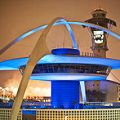
Did you know… Googie architecture
Googie architecture is a form of modern architecture, a subdivision of futurist architecture influenced by car culture and the Space and Atomic Ages. Originating in Southern California during the late 1940s and continuing approximately into the mid-1960s, Googie-themed architecture was popular among motels, coffee houses and gas stations. The term “Googie” comes from a now defunct coffee shop and cafe built in West Hollywood.
Features of Googie include upswept roofs, curvaceous, geometric shapes, and bold use of glass, steel and neon. Googie was also characterized by Space Age designs depicting motion, such as boomerangs, flying saucers, atoms and parabolas, and free-form designs such as “soft” parallelograms and an artist’s palette motif. These stylistic conventions represented American society’s fascination with Space Age themes and marketing emphasis on futuristic designs.
As with the Art Deco style of the 1930s, Googie became less valued as time passed, and many buildings built with this style have been destroyed. Some examples of the style have been preserved, such as the oldest McDonald’s stand qualifying for the National Register of Historic Places in 1983.